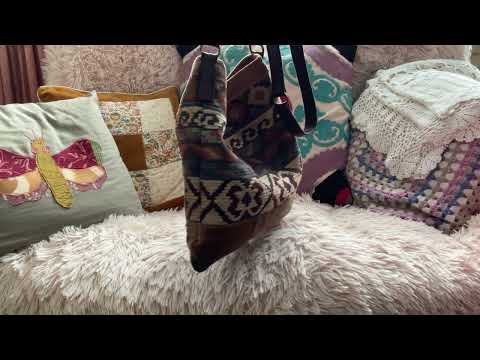Kilim fabric is a captivating textile that exudes rich cultural heritage and timeless beauty. Originating from the ancient civilizations of Central Asia, this intricately woven material showcases a mesmerizing tapestry of colors, patterns, and motifs. With its vibrant hues, exquisite craftsmanship, and unparalleled versatility, kilim fabric has the power to effortlessly transform any space into a captivating work of art. Whether adorning the floors as rugs, gracing walls as tapestries, or accentuating furniture as upholstery, this fabric radiates a distinct aura of authenticity and charm. Each kilim fabric narrates a unique story, reflecting the rich history and cultural traditions of its origins. The intricate geometric designs and bold motifs evoke a sense of wanderlust, inviting you to embark on a visual journey to distant lands. The time-honored weaving techniques employed by skilled artisans result in a fabric that is not only visually stunning but also incredibly durable, making it a cherished heirloom that can be passed down through generations. Experience the magic of kilim fabric and let it enchant your senses with its captivating beauty and cultural significance.

The History and Origins of Kilim Fabric
Kilim fabric is a centuries-old textile that has been used by various cultures throughout history. Its origins can be traced back to ancient times, with evidence of its existence found in archaeological sites in Egypt, Turkey, and Iran. The word “kilim” is derived from the Persian word “gelim,” which means “to spread roughly.”
Characteristics of Kilim Fabric
Kilim fabric is known for its unique characteristics, making it a popular choice for home decor and fashion accessories. It is handwoven using a flat weaving technique, which results in a flat surface with no pile. This technique gives kilim fabric its distinct appearance and texture. Additionally, kilim fabric is often made from natural materials such as wool, cotton, or silk, making it durable and long-lasting.
The Versatility of Kilim Fabric
Kilim fabric is highly versatile, as it can be used in various ways to enhance the aesthetic appeal of any space. One of the most common uses of kilim fabric is in rugs and carpets. Kilim rugs are known for their vibrant colors and intricate patterns, which can instantly transform a room. Additionally, kilim fabric can be used to make pillows, upholstery, and even clothing, allowing individuals to incorporate its unique style into their everyday lives.
The Cultural Significance of Kilim Fabric
Kilim fabric holds great cultural significance, as it is deeply rooted in the history and traditions of the regions where it originated. In many Middle Eastern and Central Asian cultures, kilim rugs are considered an important part of a household’s wealth and status. These rugs are often passed down through generations and are used as decorative pieces during special occasions and celebrations. Furthermore, the intricate patterns and motifs found in kilim fabric often carry symbolic meanings, reflecting the beliefs and values of the community that created them.
Preserving and Appreciating Kilim Fabric
In recent years, there has been a growing interest in preserving and appreciating kilim fabric as a valuable cultural heritage. Many organizations and artisans are working to ensure the survival of traditional kilim weaving techniques by providing training and support to local communities. Additionally, there are numerous exhibitions and museums dedicated to showcasing the beauty and craftsmanship of kilim fabric. By promoting awareness and understanding of kilim fabric, we can contribute to the preservation of this ancient art form for future generations.
In Conclusion
Kilim fabric is not just a textile; it is a piece of history and culture. From its ancient origins to its versatile uses in modern times, kilim fabric continues to captivate and inspire people around the world. Its unique characteristics, cultural significance, and efforts to preserve and appreciate it make kilim fabric a truly remarkable and timeless art form.
“Crafted Kilim Crossbody: The Perfect Artisanal Accessory”
List about kilim fabric:
Table: Kilim Fabric
| Property | Description |
|---|---|
| Origin | Kilim fabric, also known as flatweave, originates from various regions including Turkey, Iran, Afghanistan, and parts of Central Asia. Each region boasts its unique patterns, colors, and weaving techniques, making kilim fabric a captivating piece of cultural heritage. |
| Material | Kilim fabric is traditionally handwoven using natural materials such as wool, cotton, and occasionally silk. The combination of these fibers results in a durable and versatile textile that showcases vibrant colors and intricate patterns. |
| Weaving Technique | The weaving technique employed in kilim fabric is known as flatweave or slit-weave. This technique involves tightly interweaving the weft (horizontal) and warp (vertical) threads, creating a flat surface without any pile. The absence of a pile gives kilim fabric its characteristic lightness and flexibility. |
| Designs and Patterns | Kilim fabric is renowned for its rich array of designs and patterns. These motifs often reflect the cultural heritage and symbolism of the region where they are crafted. Common kilim patterns include geometric shapes, floral motifs, animal figures, and traditional symbols. Each design carries its unique story, making kilim fabric a mesmerizing piece of art. |
| Usage | Kilim fabric finds versatile applications in both decorative and functional purposes. It is widely used as rugs, wall hangings, upholstery, pillows, and even fashion accessories. The vibrant colors and intricate patterns of kilim fabric effortlessly enhance any space, adding warmth, character, and a touch of cultural charm. |
| Maintenance | Caring for kilim fabric requires gentle handling to preserve its beauty and longevity. Regular vacuuming and spot cleaning are recommended to prevent dust accumulation and maintain its vibrant colors. Avoid excessive exposure to direct sunlight to prevent fading, and professional cleaning is advisable for deep cleaning and stain removal. |
Note: Kilim fabric is a fascinating cultural textile that deserves appreciation for its craftsmanship, history, and artistic value.

